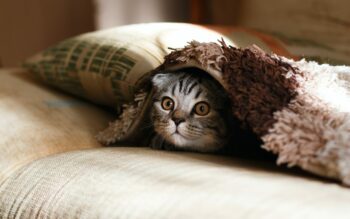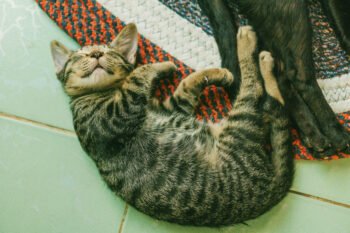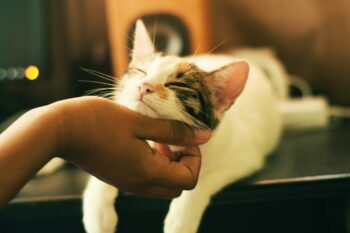This fall, you may notice a change in your veterinarian. Rather than checking kitty’s teeth and asking about her diet, your vet may ask you about her recent behavior and if there’s been any drastic changes in your home life. No, she hasn’t decided all of a sudden to be nosy. Instead, in all likelihood, she read the hot-off-the-press American Academy of Feline Practioners’ (AAFP) Feline Behavior Guidelines — the first to address the mental health and well-being of our beloved feline family members.
In addition to running the University of Pennsylvania School of Veterinary Medicine’s Behavior Clinic for 12 years, and writing the best-selling Clinical Behavioral Medicine for Small Animals and The Manual of Small Animal Behavioral Medicine (due out from Elsevier at the end of the year), Karen L. Overall, MA, VMD, PhD, ABS-Certified Animal Behaviorist, is also the lead scientist of several recent groundbreaking studies in feline and canine behavior. So she’s more than well-qualified to be the co-chair, along with Ilona Rodan, DVM, of the AAFP’s new guidelines. Despite her incredibly hectic schedule, The Daily Cat was lucky enough to get the inside “scoop” from Overall on the AAFP’s initiative and what’s really going on inside those fuzzy feline minds.
The Daily Cat: Please tell us about the AAFP’s new guidelines.
Karen Overall: The AAFP decided that we needed guidelines for practitioners to address the behavioral health and well-being of cats, because there weren’t any. One of the most common problems faced by cat owners are elimination disorders or urinary tract disease. Most urinary tract disease is linked to anxiety. And most of the anxiety has to do with social disorders and needs that are not being met. But many vets out there don’t have a clue that this is happening. Not only are cats understudied, people don’t think they need to be studied. The attitude is that we have dogs and cats have us.
The Daily Cat: And that cats are low-maintenance pets. Leave them alone for a weekend with a bunch of food, the litter box, and maybe a ball.
Karen Overall: And that’s why we tend to think they’re well-behaved, when they’re [actually] depressed or frozen. Many times the client identifies a cat who they think is behaving the way they want, but that cat is frightened. They don’t realize that cat who is nice, that cat who is quiet, that cat who is sitting very still on the bookcase is terrified. It’s not knocking things off the bookcase or running through the house. But it doesn’t have a life. If you look at a catalogue for pet stuff, there’ll be 200 pages of toys for dogs and five pages for cats. We don’t understand how cats play with each other or how social they are.
The Daily Cat: What about elimination disorders?
Karen Overall: Besides real simple problems such as the cat not liking the kitty litter, when we went back through our data, we found that almost without exception elimination complaints were linked to some sort of social situation in the house. This is very similar to obsessive-compulsive disorder (OCD). We were much more likely to see cats develop OCD if there was a social stressor in the household, such as the addition of a cat, the death of a cat, a household move, or a change in some sort of relationship, human or animal.
The Daily Cat: What sort of stress can a cat have?
Karen Overall: What our research has shown is that an awful lot of stress in cats is the same stress we have. To a large extent, stress is not just in our head, but made by our head. The way you deal with what’s on your plate tends to be determined by your genes. There are people who are going to be anxious no matter how calm their life is. Their neurochemistry produces chemicals that make them anxious, and there are a lot of cats like that. In fact, I think there are more cats like that because we never truly domesticated them. [They were] adapted completely to another environment.
The Daily Cat: What are some signs of stress that a cat owner can recognize?
Karen Overall: One sign is if their cat used to dig in the litter box, but since they brought that other cat home or that new boyfriend, the cat’s standing on the edge of the litter box and not scratching. The key is to know what normal is. The classic sign of urinary tract infection is when the cat urinates frequently in small amounts because it hurts. People tend not to watch their cats go to the bathroom — and they really need to.
The Daily Cat: What can you do to relieve stress?
Karen Overall: There are lots of ways you can increase the complexity of the social or physical environment. Most people really don’t want to have empty cardboard boxes sitting all over the house, but if you’ve got a terrace, you can screen it in. That can work very, very well for many animals. They can sit out there and smell stuff, but they’re still safe. I would use food toys and roller treat balls. I love the little scratching posts where if they scratch hard enough, treats will come out. You can arrange things so cats share time and space, too. If you’ve got two cats and you live in a small apartment and you think one cat is making the other one a little stressed, you can separate them so that they each have independent time, and set up games and interactions that each one likes.
The Daily Cat: Are feline behavioral problems different from canine behavioral problems?
Karen Overall: Cats need an environmental trigger. They’re so susceptible to changes in the environment. I wonder how many cats we [at the clinic] are seeing who are just chronically depressed, because they don’t have anything they can do. There are no options for them socially and intellectually.
The Daily Cat: I think many people don’t realize they have an intelligent predator living in their house.
Karen Overall: People don’t see cats as really bright, inherently cognitive individuals. They forget the most critical need, which to me is the intellectual one. I think we haven’t given cats or dogs the credit they deserve for their cognitive capabilities. I think we’ve got an epidemic of understimulated cats whose intellectual needs aren’t being met. So, food puzzles and mazes and cat trees and screened-in areas outdoors will all help to lower cats’ stress levels and give them some choices.







